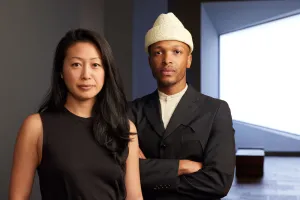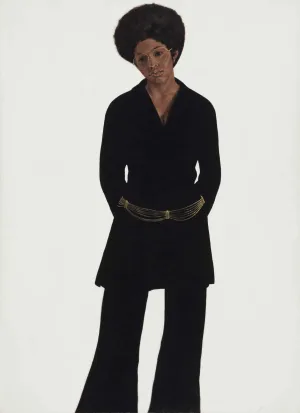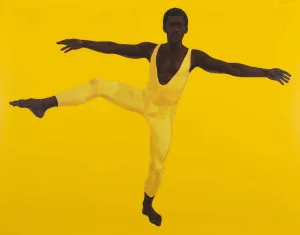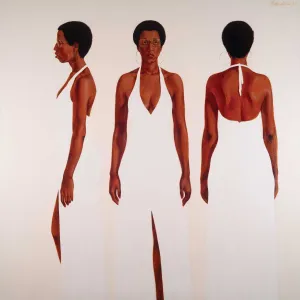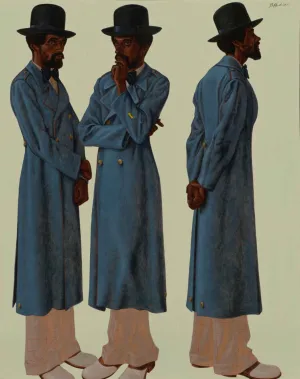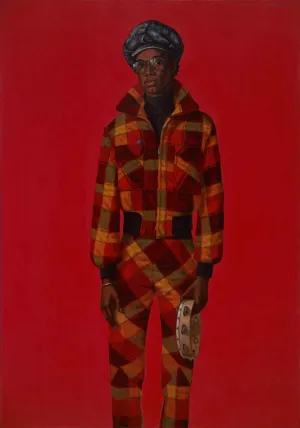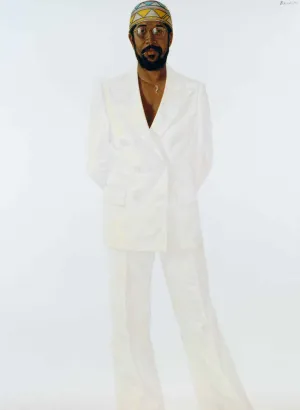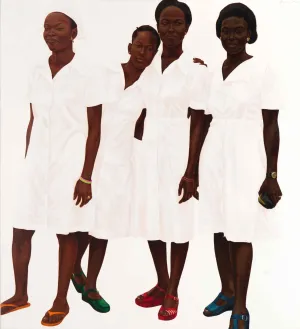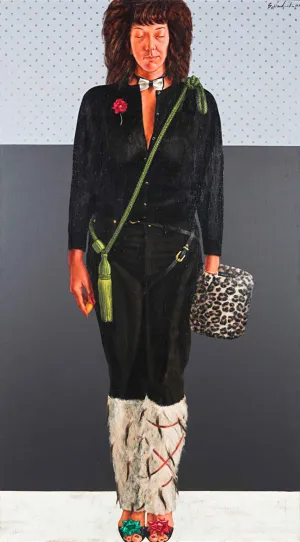Audio
Curators' Tour
Barkley L. Hendricks: Portraits at the Frick is curated by Aimee Ng and Consulting Curator Antwaun Sargent.
Listen to the curators' tour of the exhibition.
Barkley L. Hendricks (American, 1945–2017)
Miss T, 1969
Oil and acrylic on canvas
66 1/8 x 48 1/8 in. (168 x 122.2 cm)
Philadelphia Museum of Art, Philadelphia; Purchased with the Philadelphia Foundation Fund, 1970
© Barkley L. Hendricks. Courtesy of the Estate of Barkley L. Hendricks and Jack Shainman Gallery, New York.
On his first trip to Europe in 1966, Hendricks was struck by a portrait in the Uffizi gallery, in Florence, by the Italian Renaissance artist Giovanni Battista Moroni: “The figure in a black, skin-tight outfit made me see the illusion of form and simplicity in a different light.” Miss T was a “direct by-product” of this encounter with the four-hundred-year-old painting. Hendricks’s subject, Robin Taylor, was his then-girlfriend: “Several paintings come with good color besides what’s on their canvases.
Barkley L. Hendricks (American, 1945–2017)
Woody, 1973
Oil and acrylic on canvas
66 × 84 in. (167.6 × 213.4 cm)
Baz Family Collection
© Barkley L. Hendricks. Courtesy of the Estate of Barkley L. Hendricks and Jack Shainman Gallery, New York.
This is one of the earliest of the paintings Hendricks described as having a “limited palette”—works in which the figure (except for the skin) and background are presented nearly monochromatically. The varnished oil paint used for the figure contrasts with the matte acrylic of the background to create a distinction in materials and surface visible only when the paintings are viewed firsthand. Striking one of the most dramatic poses of any of Hendricks’s figures, the subject was recently identified by Richard J.
Barkley L. Hendricks (American, 1945–2017)
October’s Gone . . . Goodnight, 1973
Oil and acrylic on canvas
66 × 72 in. (167.6 × 182.9 cm)
Harvard Art Museums/Fogg Museum, Cambridge; Richard Norton Memorial Fund
© Barkley L. Hendricks and President and Fellows of Harvard College. Courtesy of the Estate of Barkley L. Hendricks and Jack Shainman Gallery, New York.
The Three Graces, figures from Greek mythology, was a popular motif for artists throughout early modern European art—from Sandro Botticelli to Peter Paul Rubens to Antonio Canova. Hendricks acknowledged the “direct influence” of the theme on this portrait of an unnamed Connecticut College student. She had sent anonymous letters to Hendricks, and, after he learned her identity, she posed for him. “She was married at the time,” he recalled, and her husband came to the studio.
Barkley L. Hendricks (American, 1945–2017)
Bahsir (Robert Gowens), 1975
Oil and acrylic on canvas
83 1/2 × 66 in. (212.1 × 167.6 cm)
Nasher Museum of Art at Duke University, Durham; Museum purchase with additional funds provided by Jack Neely
© Barkley L. Hendricks. Courtesy of the Estate of Barkley L. Hendricks and Jack Shainman Gallery, New York. Photo Brian Quinby.
Hendricks described the sitter as “a good friend from Philadelphia” who visited him in New London, Connecticut. The arched windows of Hendricks’s State Street studio are reflected in the eyes of the central figure. Like October’s Gone . . . Goodnight, Bahsir draws on the classical motif of the Three Graces, the triple-portrait format suited for subjects for whom he “felt that one pose was not enough.” Here, however, two of the figures slightly overlap, enhancing the illusion of the bodies in space.
Barkley L. Hendricks (American, 1945–2017)
Blood (Donald Formey), 1975
Oil and acrylic on canvas
72 × 50 1/2 in. (182.9 × 128.3 cm)
Collection of Jimmy Iovine and Liberty Ross
© Barkley L. Hendricks. Courtesy of the Estate of Barkley L. Hendricks and Jack Shainman Gallery, New York.
Donald Formey was a student at Connecticut College. For this limited-palette painting, Hendricks altered the sitter’s clothes as he did in many of his portraits. Formey had worn jeans to model, but Hendricks painted him wearing plaid pants that matched the pattern of his jacket. Over the course of the sittings, Hendricks added the tambourine. Formey recounts that the artist gave him the instrument to pose with after he noticed him tapping his foot to the music playing in his studio.
Barkley L. Hendricks (American, 1945–2017)
Slick, 1977
Magna, acrylic, and oil on canvas
67 × 48 1/2 in. (170.2 × 123.2 cm)
Chrysler Museum of Art, Norfolk; Gift of the American Academy and Institute of Arts and Letters, New York
© Barkley L. Hendricks. Courtesy of the Estate of Barkley L. Hendricks and Jack Shainman Gallery, New York.
Regarding self-portraiture, Hendricks wrote: “‘Since you are always around’ was one of the descriptions I heard to define self-portraiture.
Barkley L. Hendricks (American, 1945–2017)
Lagos Ladies (Gbemi, Bisi, Niki, Christy), 1978
Oil, acrylic, and Magna on canvas
72 × 60 in. (182.9 × 152.4 cm)
Private collection
© Barkley L. Hendricks. Courtesy of the Estate of Barkley L. Hendricks and Jack Shainman Gallery, New York.
In 1977, Hendricks traveled to Lagos, Nigeria, to attend FESTAC (Second World Black and African Festival of Arts and Culture). There he met these women, who worked as cooks at a hotel. Photographs show them outdoors, standing on sandy ground. Transporting them to the flatness of a white-on-white painting, Hendricks showcases the range of the women’s skin tones and variety of their shoes.
Barkley L. Hendricks (American, 1945–2017)
Ma Petite Kumquat, 1983
Oil, acrylic, white gold, and silver leaf on canvas
72 x 40 in. (182.9 x 101.6 cm)
Collection Ben and Jen Silverman
© Barkley L. Hendricks. Courtesy of the Estate of Barkley L. Hendricks and Jack Shainman Gallery, New York.
Hendricks painted this portrait of his wife, Susan, shortly after the couple married. The title comes from the small orange fruit held in the sitter’s hand: “I needed an additional warm color. So that little piece of citrus...gave the painting just what it needed as well as its name.” Susan modeled both for photographs and for live sittings, and Hendricks later added accessories like the green curtain pull, bow tie, muff, leg warmers, and bows on the shoes. He applied the silver-leaf dots on the upper register using the back end of a pencil.

